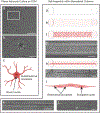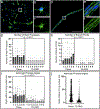Unique Astrocyte Cytoskeletal and Nuclear Morphology in a Three-Dimensional Tissue-Engineered Rostral Migratory Stream
- PMID: 36776937
- PMCID: PMC9910099
- DOI: 10.3390/neuroglia3010003
Unique Astrocyte Cytoskeletal and Nuclear Morphology in a Three-Dimensional Tissue-Engineered Rostral Migratory Stream
Abstract
Neural precursor cells (NPCs) are generated in the subventricular zone (SVZ) and travel through the rostral migratory stream (RMS) to replace olfactory bulb interneurons in the brains of most adult mammals. Following brain injury, SVZ-derived NPCs can divert from the RMS and migrate toward injured brain regions but arrive in numbers too low to promote functional recovery without experimental intervention. Our lab has biofabricated a "living scaffold" that replicates the structural and functional features of the endogenous RMS. This tissue-engineered rostral migratory stream (TE-RMS) is a new regenerative medicine strategy designed to facilitate stable and sustained NPC delivery into neuron-deficient brain regions following brain injury or neurodegenerative disease and an in vitro tool to investigate the mechanisms of neuronal migration and cell-cell communication. We have previously shown that the TE-RMS replicates the basic structure and protein expression of the endogenous RMS and can direct immature neuronal migration in vitro and in vivo. Here, we further describe profound morphological changes that occur following precise physical manipulation and subsequent self-assembly of astrocytes into the TE-RMS, including significant cytoskeletal rearrangement and nuclear elongation. The unique cytoskeletal and nuclear architecture of TE-RMS astrocytes mimics astrocytes in the endogenous rat RMS. Advanced imaging techniques reveal the unique morphology of TE-RMS cells that has yet to be described of astrocytes in vitro. The TE-RMS offers a novel platform to elucidate astrocyte cytoskeletal and nuclear dynamics and their relationship to cell behavior and function.
Keywords: astrocyte; cell morphology; cytoskeleton; nuclear morphology; nucleus; rostral migratory stream; tissue engineering.
Conflict of interest statement
Conflicts of Interest: There are no other potential conflicts of interest to disclose.
Figures








Similar articles
-
A three-dimensional tissue-engineered rostral migratory stream as an in vitro platform for subventricular zone-derived cell migration.Front Bioeng Biotechnol. 2024 Jun 12;12:1410717. doi: 10.3389/fbioe.2024.1410717. eCollection 2024. Front Bioeng Biotechnol. 2024. PMID: 38933539 Free PMC article.
-
An implantable human stem cell-derived tissue-engineered rostral migratory stream for directed neuronal replacement.Commun Biol. 2021 Jul 15;4(1):879. doi: 10.1038/s42003-021-02392-8. Commun Biol. 2021. PMID: 34267315 Free PMC article.
-
Expression of ezrin radixin moesin proteins in the adult subventricular zone and the rostral migratory stream.Neuroscience. 2010 May 5;167(2):312-22. doi: 10.1016/j.neuroscience.2010.01.035. Epub 2010 Jan 28. Neuroscience. 2010. PMID: 20109539
-
A tissue-engineered rostral migratory stream for directed neuronal replacement.Neural Regen Res. 2018 Aug;13(8):1327-1331. doi: 10.4103/1673-5374.235215. Neural Regen Res. 2018. PMID: 30106034 Free PMC article. Review.
-
Tracking Neural Progenitor Cell Migration in the Rodent Brain Using Magnetic Resonance Imaging.Front Neurosci. 2019 Jan 11;12:995. doi: 10.3389/fnins.2018.00995. eCollection 2018. Front Neurosci. 2019. PMID: 30686969 Free PMC article. Review.
Cited by
-
Generation of contractile forces by three-dimensional bundled axonal tracts in micro-tissue engineered neural networks.Front Mol Neurosci. 2024 Mar 25;17:1346696. doi: 10.3389/fnmol.2024.1346696. eCollection 2024. Front Mol Neurosci. 2024. PMID: 38590432 Free PMC article.
-
A three-dimensional tissue-engineered rostral migratory stream as an in vitro platform for subventricular zone-derived cell migration.Front Bioeng Biotechnol. 2024 Jun 12;12:1410717. doi: 10.3389/fbioe.2024.1410717. eCollection 2024. Front Bioeng Biotechnol. 2024. PMID: 38933539 Free PMC article.
-
Single-mitochondrion sequencing uncovers distinct mutational patterns and heteroplasmy landscape in mouse astrocytes and neurons.BMC Biol. 2024 Jul 29;22(1):162. doi: 10.1186/s12915-024-01953-7. BMC Biol. 2024. PMID: 39075589 Free PMC article.
References
Grants and funding
LinkOut - more resources
Full Text Sources
Miscellaneous
